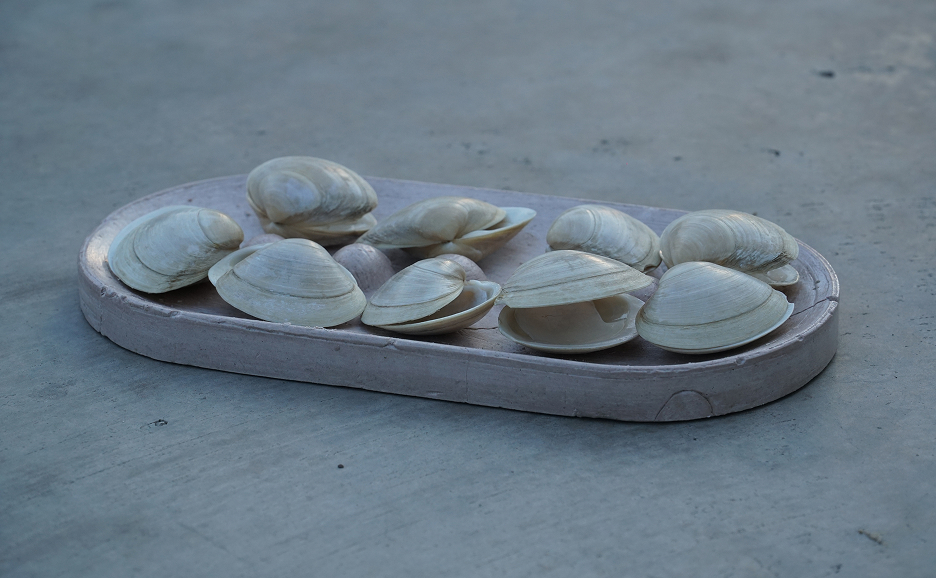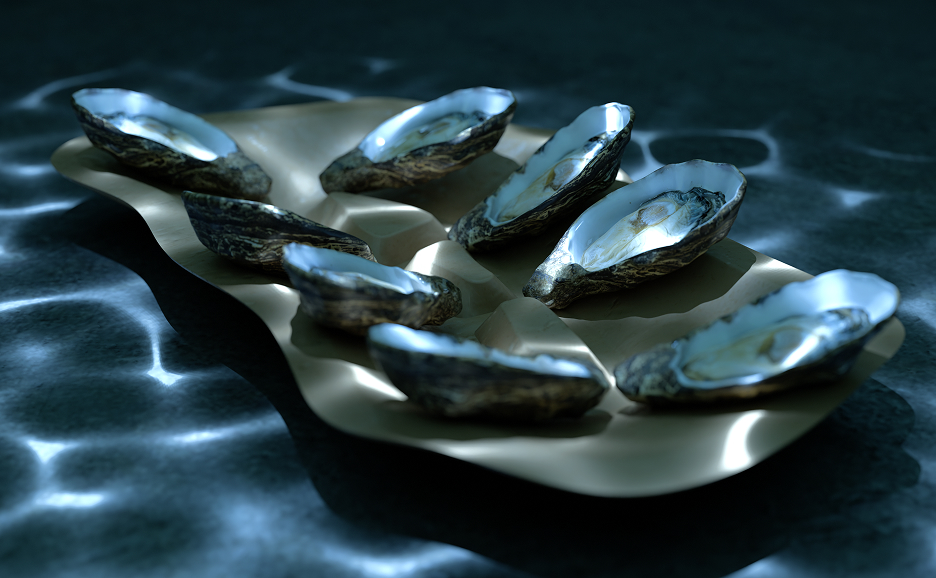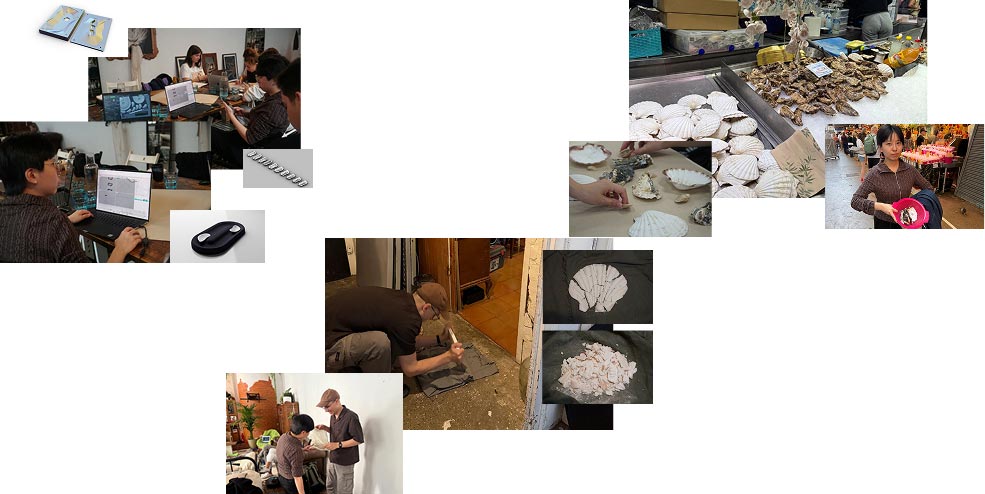SOS – TRANSFORMING SEAFOOD WASTE
CONCEPT
from the sea to the plate and back to the table – this project transforms discarded SEASHELLS into elegant serving trays, allowing nature’s remnants to be reused in a refined form.
This project explores the transformation of food waste into functional design by repurposing discarded seashells into refined serving trays. After the shells are cleaned, dried, and ground into a fine mineral-rich powder, they are used to form sturdy, decorative trays. Designed for use in fine dining or cocktail settings, each tray not only elevates the presentation of food but also serves as a quiet statement on circularity and conscious consumption. By returning seashells to the table in a new form, the project creates a sensory and symbolic loop, where what was once discarded becomes integral to the dining experience again.
TEAM
As designers, we are uniquely positioned to contribute to reducing environmental pollution and significantly drive awareness towards an environmentally sustainable and responsible future.
Lazar Avramovski is an Industrial Designer based in Delft, Netherlands. He is currently pursuing his Master’s studies at TU Delft in the field of Product Design. Lazar’s primary work centers on practical projects that allow him to explore different materials and their properties. Currently, he is focused on developing ecologically conscious designs that integrate sustainable principles into the design process.
Personal Reflection: Participating in the NextGen design residency during Barcelona Design Week was an incredibly enriching experience, both creatively and culturally. The inspiring atmosphere, shaped by the city’s energy, the exchange of ideas, and the support of fellow designers, greatly fueled my creative process and led to the development of fresh, innovative concepts. Immersed in Barcelona’s vibrant culture, I was encouraged to blend interdisciplinary techniques and methods with my teammates and fellow designers, expanding my approach to the design process. We explored the city as if we were locals, discovering hidden corners and drawing inspiration from everyday life. A highlight of the residency was conducting field research on waste at La Boqueria market, where we investigated examples of food industry waste and reflected on sustainable practices. Overall, the residency was a truly transformative experience that deepened my perspective, inspired new ideas, and broadened my design horizons.
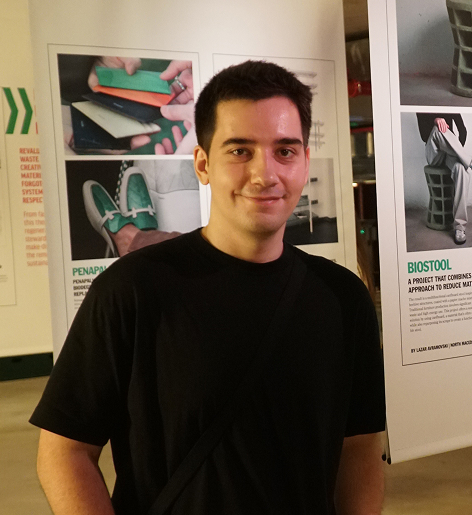
I explore the intersection of technology, biology, and ethics through interactive installations and bioart. My work challenges perceptions of agency, sustainability, and artificial intelligence, creating speculative futures.
Boldi is a versatile visual artist engaged in a wide range of projects, from visual storytelling to immersive multimedia experiences. Currently pursuing a Master’s in Media Design at Moholy-Nagy University of Arts and Design, he excels in problem-solving and thrives on learning, adeptly navigating diverse projects and technologies. He enjoys taking on new challenges and bringing creative projects to life.
Visiting IAAC was truly inspiring. Seeing the wide range of machines available to students and the variety of projects they create with them was impressive.
Working with the team was a valuable learning experience – our backgrounds differed not only by discipline but also by scale: an architect, a product designer, and a visual artist. It turned out to be the perfect match; our workflow was seamless, and problem-solving came naturally. I also appreciated that everyone had the chance to try something new and step outside their comfort zone.
Having hands-on experience with food waste – both in real-life contexts such as markets and restaurants, and through working with a food designer using food scraps – made our ideation and realization process feel intuitive and well-grounded.
Architecture should be imaginative and grounded, driven by social purpose, environmental resilience, and a clear understanding of the economic systems that shape our world.
Jacqueline’s interest in architecture was ignited during a high school trip to Mai Châu, Vietnam, where she helped build a home for a disadvantaged family, fostering her passion for socially responsive design. At The Bartlett School of Architecture, she explored innovative methodologies—from wearable spatial tools to adaptive floating infrastructures—demonstrating her commitment to creative experimentation and environmental resilience. Her postgraduate project, The Flooding School for Amphibious Living, exemplified this ethos. Currently at Broadway Malyan, Jacqueline has gained insights into the business of architecture and leadership within an Employee-Owned Trust. She is developing robust business acumen alongside her design skills, aiming to bridge commercial and socially driven practices, addressing pressing societal challenges through architecture while navigating the complexities of a capitalist system.
Personal Reflection: My experience in Barcelona has broadened my perspective as a designer — not just as an architect — revealing new possibilities in circular design and the innovative reuse of food waste. I’ve always been drawn to radical ideas that challenge identities, processes, and thus outcomes, yet I often found these difficult to apply in real-world contexts. The NEXT GEN DESIGN Barcelona Residency offered a refreshing shift: it demonstrated how small, thoughtful interventions can spark meaningful change. I was deeply impressed by the dedication and creativity of the food waste start-up entrepreneurs we met, whose work turned discarded materials into purposeful innovations. The programme expanded my horizon, connecting me with designers from diverse disciplines and encouraging genuine exchange — exploring how sustainability can be embedded into design practice in tangible and inspiring ways.
PROCESS
SKETCHES
brainstorming on possibilities to Reimagine food waste through design inspired by Barcelona’s coastal culture.
During the sketching phase of our project – centered around the question, “How might we transform food waste into functional design objects that spark circular economies and redefine sustainability in everyday life?”- we explored a wide range of materials, concepts, and potential influences.
Through brainstorming sessions and quick sketches, we began to notice a strong connection between our project’s goals and the local context of Barcelona, a coastal city renowned for its vibrant culinary scene. This led us to focus on seafood waste as a promising direction, given its abundance and often – overlooked potential. We ultimately honed in on reusing discarded shells from oysters, mussels, and other shellfish as our primary material.

MATERIALS
exploring Barcelona’s local markets and researching shell waste from stall workers
The decision to use discarded seafood shells, such as those from oysters, mussels, and clams was based on their strong aesthetic qualities and environmental potential. During our research phase, we visited La Boqueria, one of Barcelona’s most iconic local markets, where we spoke with stall workers who regularly deal with large volumes of shellfish. Many of them were happy to offer us shells for free, as these were considered waste – often used temporarily for display before piling up and eventually being thrown away. Their unique textures, durability, and local availability made them an ideal candidate for reimagining waste as a resource, perfectly aligning with our goal of creating functional design objects that promote circularity.
FINAL ARTWORK
A serving tray designed to elegantly present oysters or mussels in fine dining and cocktail settings.
The final outcome of our project is a serving tray that incorporates crushed seafood shells, ground into a fine powder and mixed with plaster to create a refined, stone-like surface. Designed for use in fine dining settings, the tray offers a sustainable way to serve oysters or mussels in restaurants or a cocktail bar setting, bringing new value to what was once considered waste. The concept follows a circular narrative: from the sea to the plate and back to the table again. While the current prototype uses plaster as a binder, the long-term vision is to develop a fully sustainable material by replacing it with a clay or ceramic-based mix, making the tray functional, elegant, and environmentally responsible.
